Men’s Leather Slippers with Leather Soles: Ultimate Guide

Author: Andy Hong | Founder at XDS
Hi, I'm Andy Hong, here to share my expertise in footwear manufacturing with you.
Men’s Leather Slippers with Leather Soles: Ultimate Guide
Table of Contents
What makes men’s leather slippers with leather soles a preferred choice for luxury and durability in footwear production? The answer lies in their timeless appeal and superior functionality.
As a footwear manufacturing consultant with years of experience sourcing materials, I have simplified the complexities of choosing the best materials and designs for leather slippers.
Leather soles offer a unique combination of aesthetic elegance and functional durability, while the quality of the leather used significantly impacts the final product.
In this guide, discover the benefits of leather soles, the types of leather available, and practical tips for choosing the best options for slippers. You will learn insights that support quality production.
Keep reading to learn more!
1. Benefits of Leather Soles in Slippers
Leather soles stand out for their sophistication and functionality, making them a preferred choice for luxury footwear. Here are the key benefits of incorporating leather soles into men’s slippers:
Aesthetic Appeal That Elevates Product Perception
Leather soles bring a polished and sophisticated appearance to men’s slippers, instantly elevating their market appeal. This refined look aligns well with premium slipper designs, attracting customers who value understated luxury. By incorporating leather soles, businesses can create a product that looks high-end and also appeals to a discerning clientele seeking quality and elegance.
Durability and Comfort That Meet Long-Term Needs
Leather soles are designed to endure the demands of frequent use while maintaining their structural integrity. The breathability of leather also promotes comfort by allowing air circulation, preventing discomfort from trapped heat or moisture. Over time, the soles mold to the shape of the wearer’s feet, offering a custom-fit feel that enhances user satisfaction and loyalty.
Grip and Flexibility for Everyday Functionality
The combination of grip and flexibility makes leather soles ideal for indoor slippers, addressing both safety and usability. At XDS, our leather soles provide reliable traction on smooth surfaces, reducing the likelihood of slips, which is especially important in professional or luxury settings. At the same time, their flexible nature supports ease of movement, making sure that the slippers are practical and also comfortable for daily use.
Sustainability That Aligns With Market Trends
As consumer preferences shift toward sustainable products, leather soles offer an eco-friendly alternative to synthetic materials. For instance, being biodegradable, leather reduces environmental impact compared to non-natural materials, making it an appealing choice for eco-conscious customers. Businesses that source their leather responsibly can further position themselves as environmentally responsible brands.
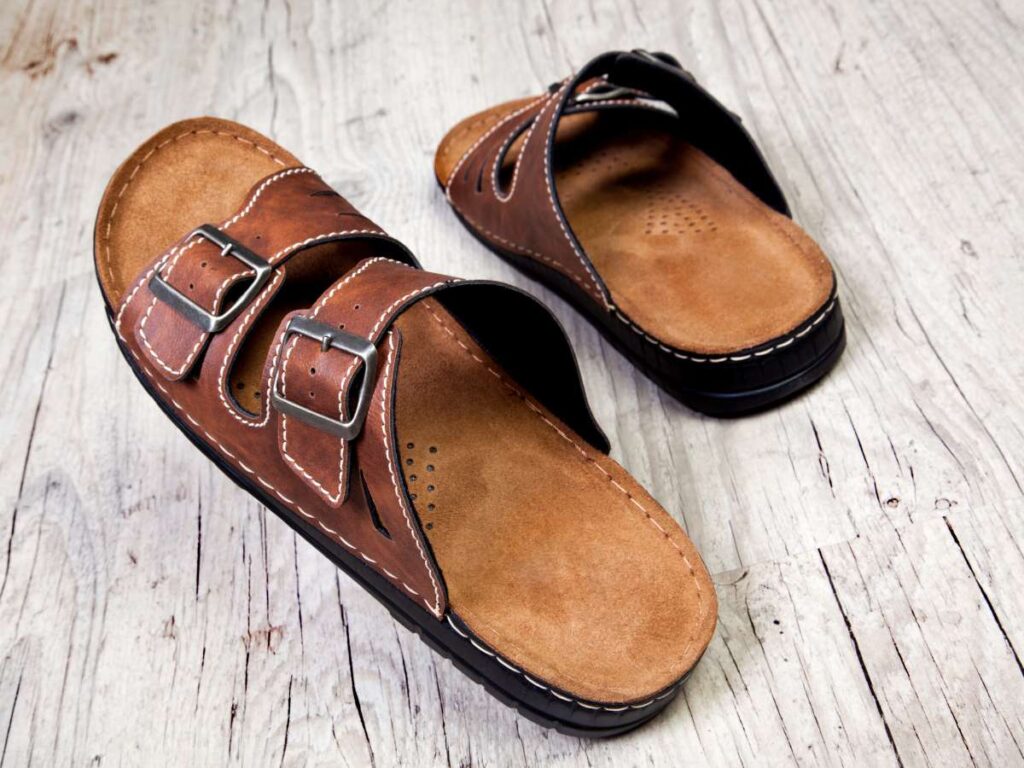
2. Types of Leather Used in Men’s Slippers
The type of leather chosen significantly affects the quality, durability, and appeal of men’s slippers. Each type offers unique characteristics, making it suitable for specific designs and purposes. Here are the most commonly used types of leather for men’s slippers and their distinct benefits:
- Full-Grain Leather: This leather type is the highest quality, retaining the natural grain for maximum strength and durability. It ages beautifully over time, developing a rich patina that enhances its aesthetic appeal.
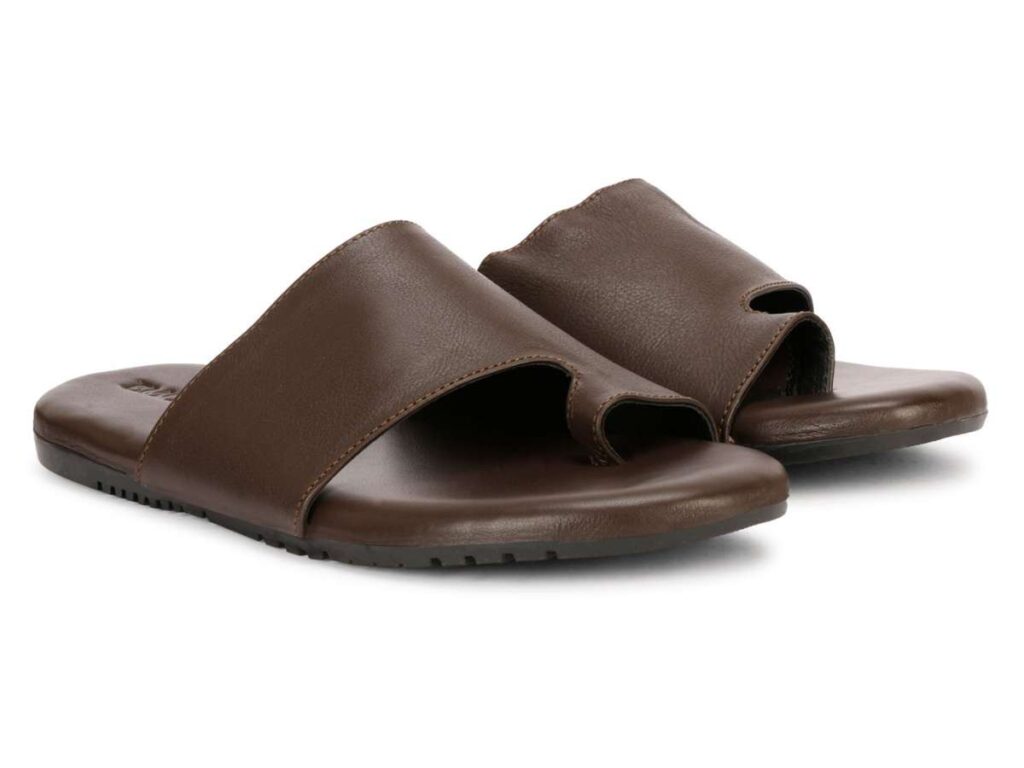
- Top-Grain Leather: Slightly thinner and more refined, top-grain leather offers a smoother surface and polished finish. It is ideal for designs that emphasize elegance without sacrificing durability.
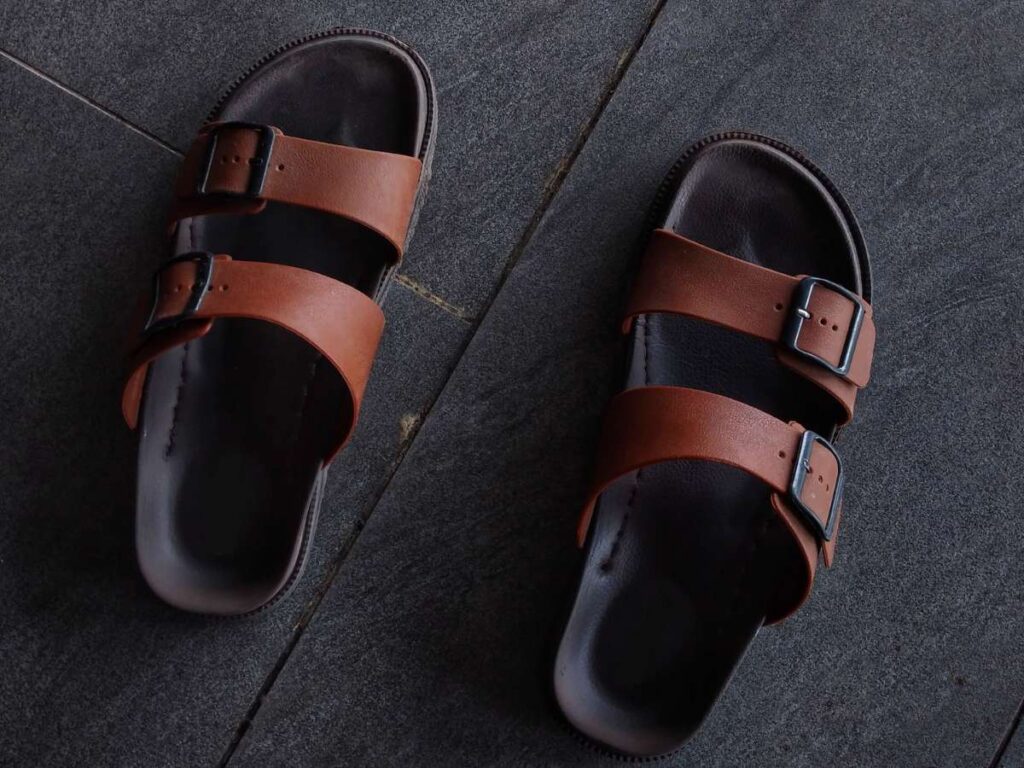
- Suede Leather: Suede features a soft, velvety texture created by sanding the inner layer of the hide. Its lightweight and casual appeal makes it a popular choice for indoor and relaxed designs.
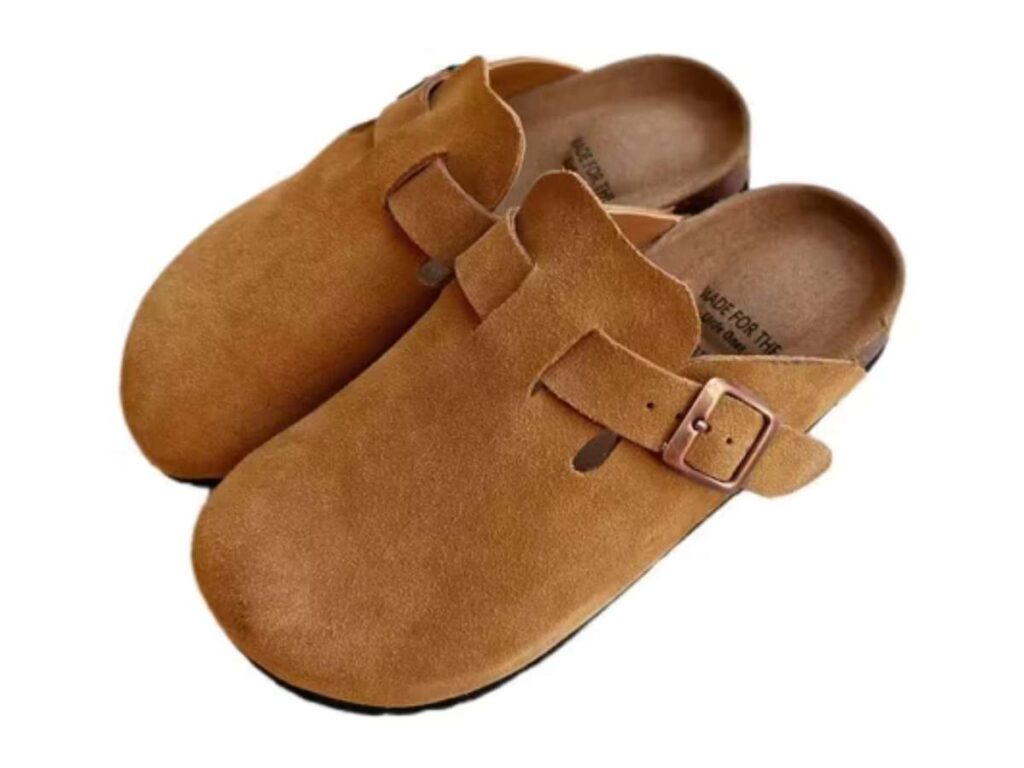
- Nubuck Leather: Nubuck is similar to suede but made by buffing the outer side of the hide, resulting in a soft yet more durable surface. It provides a luxurious feel while offering better resistance to wear than traditional suede.
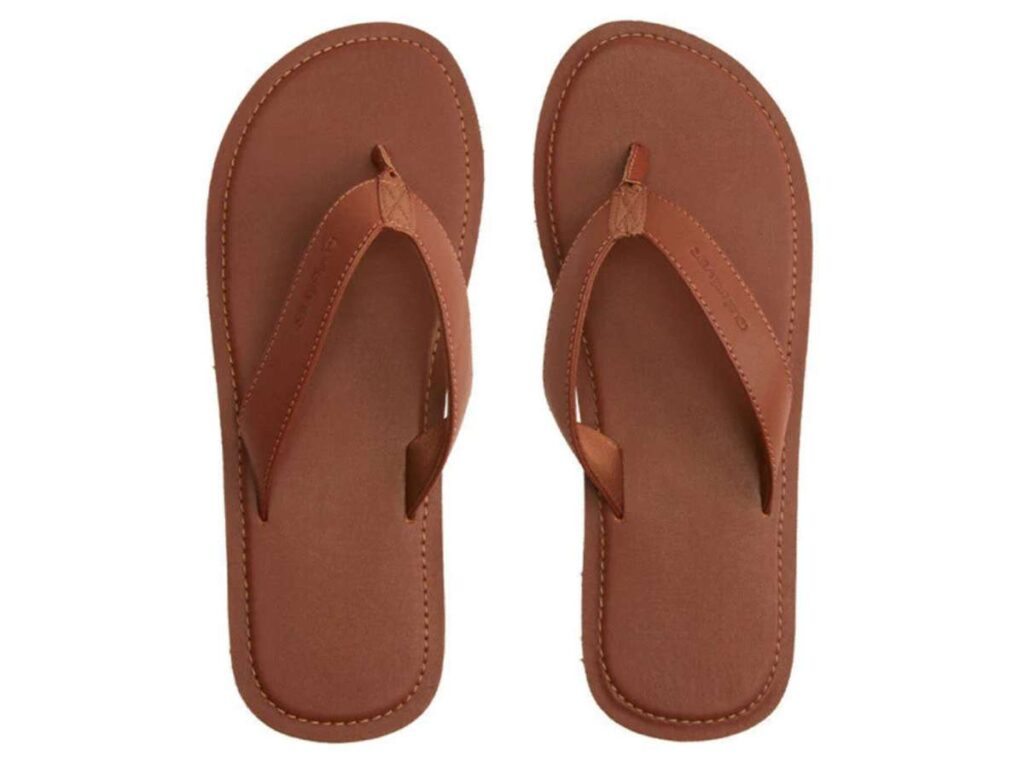
- Patent Leather: This leather type is coated with a glossy finish, making it a standout choice for formal or decorative slippers. Its sleek and shiny appearance adds a touch of sophistication, perfect for special occasions.

3. Different Styles of Men’s Leather Slippers
Men’s leather slippers come in a variety of styles, each tailored to specific needs and preferences. Below are the most popular styles of men’s leather slippers and what makes each unique:
Classic Slip-On Slippers
Classic slip-on slippers are the go-to style for those seeking a minimalist design that prioritizes ease of wear. At XDS, these slippers feature a low-cut design and soft leather construction, making them ideal for indoor use. Their versatility allows them to pair seamlessly with both loungewear and casual attire, appealing to customers who value simplicity and practicality.
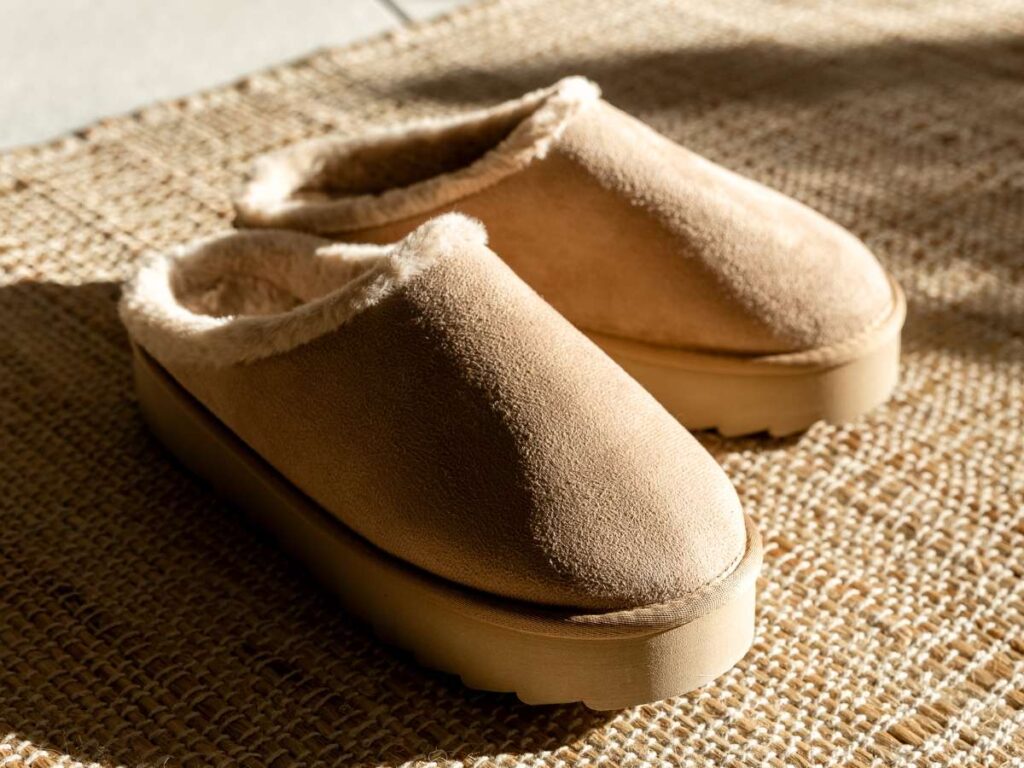
Moccasin-Style Slippers
Moccasin-style slippers are known for their stitched upper and structured design, providing a snug and cozy fit. Often crafted with supple leather or suede, these slippers exude a relaxed and approachable charm. This style blends traditional craftsmanship with modern sensibilities, appealing to those who value both comfort and a classic aesthetic.
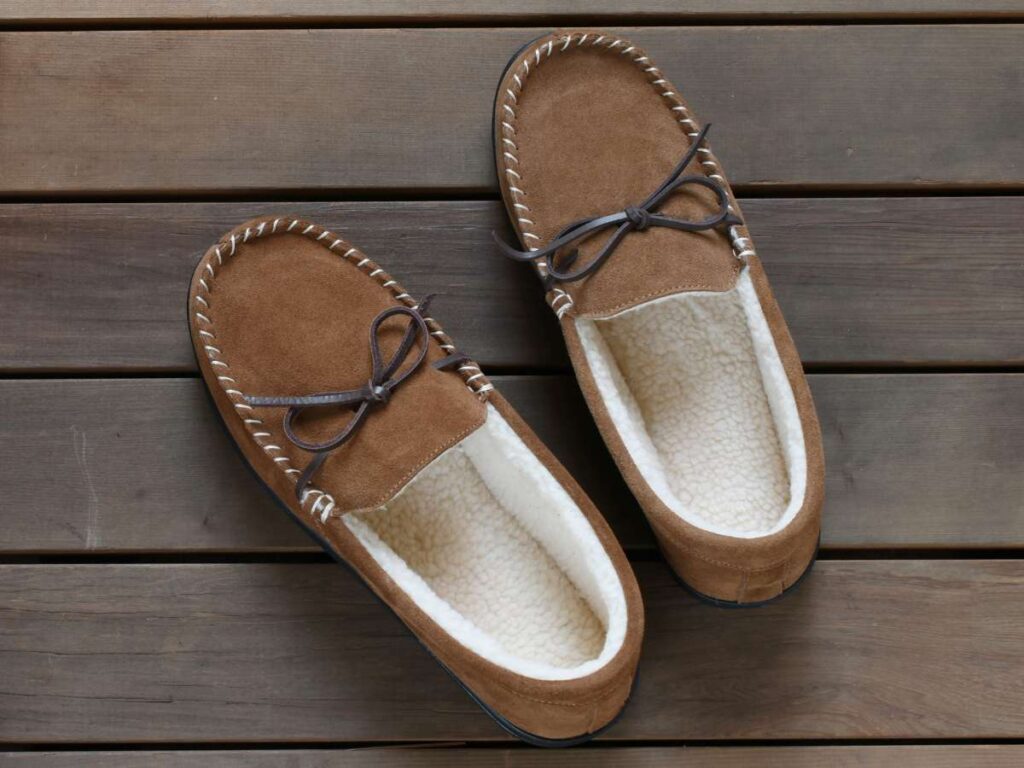
Open-Back and Mule Slippers
Open-back or mule slippers feature a backless design, offering maximum convenience without compromising on style. For instance, these slippers are crafted from high-quality leather to provide a sleek and polished look, perfect for professional or upscale settings. Their breathable design enhances comfort, making them suitable for extended wear during warmer months.

4. Comparison of Leather Soles vs. Rubber Soles
Leather soles and rubber soles each have distinct advantages, making them suitable for different purposes and customer preferences. Below is a detailed comparison to help identify the best fit for specific needs:
| Feature | Leather Soles | Rubber Soles |
| Aesthetic Appeal | Offers a sleek, elegant, and premium appearance, ideal for luxury slippers. | Provides a practical and modern look, suitable for casual designs. |
| Durability | Long-lasting but may wear down faster with heavy outdoor use. | Highly durable and resistant to wear in various environments. |
| Traction | Provides moderate grip on smooth surfaces, best suited for indoor use. | Excellent traction on both indoor and outdoor surfaces. |
| Flexibility | Lightweight and flexible, ensuring a comfortable fit and ease of movement. | Slightly heavier but offers robust support and flexibility for active wear. |
| Breathability | Naturally breathable, keeping feet cool and comfortable during extended wear. | Less breathable, which may trap heat during prolonged use. |
| Environmental Impact | Biodegradable and eco-friendly when sourced sustainably. | Non-biodegradable, with some options made from recycled materials. |
| Maintenance | Requires occasional cleaning, conditioning, and polishing to maintain quality. | Easy to clean and maintain, with minimal effort required. |
Leather soles excel in luxury, comfort, and indoor use, making them perfect for high-end slippers. Rubber soles, on the other hand, prioritize practicality, durability, and versatility for both indoor and outdoor environments. Selecting the right sole depends on the intended purpose of the slippers and the preferences of the target market.
5. Leather Care Tips for Slippers with Leather Soles
Proper care ensures that leather slippers with leather soles retain their elegance, comfort, and durability over time. Regular maintenance not only extends the lifespan of the slippers but also preserves their premium look and feel. Here are essential care tips to maintain the quality of leather slippers with leather soles:
- Clean Regularly to Maintain Professional Presentation: Dust and dirt can diminish the visual appeal of leather slippers, so wiping the surface with a damp cloth is essential. Avoid using harsh cleaning agents, as they can damage the leather and reduce the product’s lifespan.
- Condition Leather to Retain Quality Over Time: Applying leather conditioner periodically keeps the material soft and prevents cracks. Proper conditioning enhances the slipper’s value, making sure it meets the expectations of high-end clientele.
- Protect from Moisture to Prevent Damage: Excessive exposure to water can warp leather soles and compromise their durability. In case of accidental wetting, drying at room temperature helps preserve the integrity of the material.
- Polish for a Luxurious Finish: Using a neutral or color-matched leather polish not only restores shine but also adds a layer of protection against minor scuffs. Polished leather enhances the product’s overall presentation, especially for formal or luxury collections.
- Store Properly to Preserve Shape and Appearance: Slippers should be stored in a dry environment, preferably with a shoe tree or stuffing to maintain their shape. Avoid direct sunlight or heat, which can lead to discoloration and shrinkage.
- Brush Delicate Materials Like Suede or Nubuck: A soft-bristle brush is ideal for cleaning and reviving the texture of suede or nubuck slippers. This guarantees the product remains visually appealing and suitable for display or resale.
6. 4 Tips for Choosing the Right Leather for Slippers
Selecting the right leather for men’s slippers requires careful consideration of technical properties that affect durability, comfort, and overall performance. Here are 4 technical tips to guide the selection process:
#1 Opt for Leather Thickness Between 1.2mm and 2.0mm
Leather in this thickness range balances durability with flexibility, making it ideal for slippers. Thinner leather, under 1.2mm, may compromise durability, while thicker options over 2.0mm can reduce comfort and flexibility. This specification provides a sturdy structure without sacrificing wearability, particularly for high-use products.
#2 Choose Full-Grain Leather With 3% Moisture Content
Full-grain leather with a moisture content of around 3% provides enhanced durability and a soft, natural feel. This level of moisture retention prevents cracking while maintaining the leather’s integrity during prolonged use. Using full-grain leather also establishes a consistent appearance, ideal for premium markets.
#3 Verify Tensile Strength of 15–25 N/mm²
The leather used for slippers should have a tensile strength within this range to withstand regular wear and tear. Tensile strength below this threshold may result in premature stretching or tearing, while overly rigid leather can compromise comfort. Testing tensile strength makes sure that the material meets both performance and comfort requirements.
#4 Consider Grain Pattern and Porosity
Leather with a tight grain pattern and low porosity offers better resistance to wear and moisture absorption, making it ideal for indoor slippers. For more breathable designs, a slightly open grain pattern with controlled porosity improves ventilation while maintaining durability. These leather-grade properties should align with the intended usage and customer expectations for the slippers.
Conclusion
Choosing the right leather and soles for men’s slippers is crucial to creating a product that meets both durability and aesthetic demands. Understanding the different types of leather and how they influence quality guarantees that businesses can deliver premium products that stand out in the market.
We hope this guide provides valuable insights into selecting the best leather materials and designs for your production needs. With a dedicated design team, advanced quality inspection processes, and a focus on innovation, XDS provides product solutions that rival those of leading footwear manufacturers. Contact us today to discuss how we can help meet your specific needs and elevate your product offerings.
Explore More Helpful Resources
There’s more to explore! Check out our additional product selections to find exactly what you’re looking for:
Still haven’t found what you’re looking for? Don’t hesitate to contact us; we’re available around the clock to assist you.
Quick Quote
Fill out the form, get the quote in hours!





